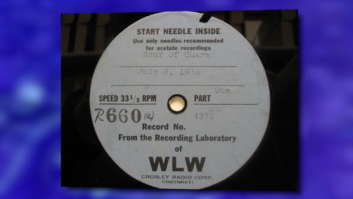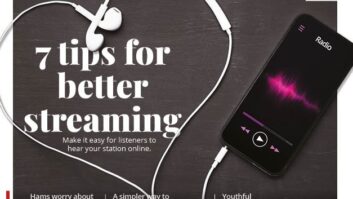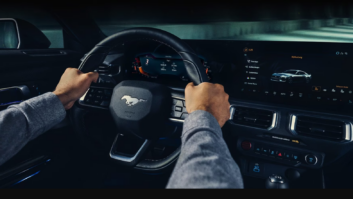AM radio needs help right now. Broadcasters must find ways to keep themselves relevant and heard to finally regain, or at least stabilize, listenership at current levels.
In order to do this, we must improve the received quality of current stations, while transitioning to a new digital broadcast band. Here is a set of suggestions that I believe could add health and longevity to the service.
1. We should seriously reevaluate Richard Arsenault’s proposal — which the FCC was quick to dismiss without even opening it up to comment — for an across-the-board power increase for all AMs. This would allow stations to punch through the current interference that renders stations unlistenable, and would not require the purchase of a single new radio to get the payoff.
It wouldn’t have to be the “10 times increase” as proposed, but there may be a reasonable middle ground at which improved signals can be cost-effective and politically palatable.

Author David Webster, shown here during a visit to an airship in Rhode Island
2. It is imperative that we implement a plan to move stations to a new broadcast band, such as the Broadcast Maximization Committee’s proposal for the Channels 5–6 spectrum, or the alternate proposal from the DRM consortium of establishment of local DRM digital in the 26 MHz space. In fact, the proposed use of DRM in the 26 MHz band has already been successfully field tested in Mexico, Germany and Brazil, with papers documenting its viability.
Broadcasters need a modern infrastructure that can be competitive and take AM into the future — one that is not prone to the unfortunate physics and haphazard allocation history of the current AM band.
3. We should allow mechanisms for “band congestion thinning,” which would allow stations to propose “negotiated” interference between each other or allow for signals to be bought for the sole purpose of surrendering or adjusting licenses to allow for stronger or better-positioned stations to up power or open their directional patterns.
Troubled or non-competitive stations could sell “accepted interference” or go dark for payment by an interested party, which is certainly a more positive option for cash-strapped signals that may be headed for permanent darkness and insolvency.
A pay-for-play environment would accelerate deals of this nature. This activity could be simultaneous to current stations making the switch to translators or a new digital band. An extension of this concept would allow a station that had attained a translator to go dark on its AM and transfer the translator status to a new type of LPFM class license.
4. Let’s look into synchronous AM transmission systems. A smaller number of synchronous “AM nodes” at lower power, scattered throughout a listening area, could keep power densities high near listeners, yet have a lower interference and skywave profile.
With GPS and today’s ability to lock transmitters in time, self-interference could be kept quite low on the same frequency with this solution. The picture becomes more interesting with digital transmission, in that the idea of SFN (single-frequency networks) with HD Radio or DRM was considered and designed into their systems from the beginning. Examining this idea of a sort of “cellular AM” might help solve some of the current issues. Additionally, it could be implemented with low-profile, albeit less-efficient, transmitting antennas and at relatively low cost due to the much lower power levels involved. Perhaps some cells could be located at business concerns, and lease considerations could be bartered for advertising time.
5. Let’s reopen the case for transmission antenna improvement. It’s astonishing that with all the supercomputing power available — which allows us to simulate everything from protein folding to nuclear weapons detonations — that we would not be able to apply our technological savvy toward creating a viable “anti-skywave antenna” for AM.
The idea of stations “turning off” or greatly reducing coverage at sunset is unbelievable today, and it harks to a different time. You certainly don’t have a fighting chance to compete with FM, SiriusXM, TV, games or Pandora … if you are effectively off the air.
6. Finally, the Web and streaming are here to stay and are quite good, if not the easiest to locate and tune into for non-techie listeners.
How about putting a data signal in AM and FM transmissions that will tell an IP-connected/enabled radio where to find it in cyberspace? When it gets a lock, it will transition to the stream, a kind of pilot tone or beacons for the Web. This could further be developed to allow for narrow/zone-casting of material or advertising based on demographic profile or the location of the receiver at a given moment.
These are just a few suggestions, and there are many more out there. But one thing is for certain: If things stay as they are now, the service will not survive, and that would be a terrible loss for current and future listeners.
I find it amazing that the conversation about opening up the airwaves to new local or niche broadcast entities via LPFM rages on, while we already have thousands of local AM broadcasters who could put up innovative and locally focused content if the revenues were there for them.
It’s simple math: Less listeners equals less revenue. If they can’t hear you, they can’t listen. I hope the ideas keep coming and that we can all put our heads together to move this service into the future.
Dave Webster is CEO of VSI/HD Media in Southington, Conn., which offers media-related production and technical services. He can be reached at [email protected]. Find information about the Broadcast Maximization Committee and the DRM papers at https://www.radioworld.com/links.
Comment about this or any story to [email protected].












